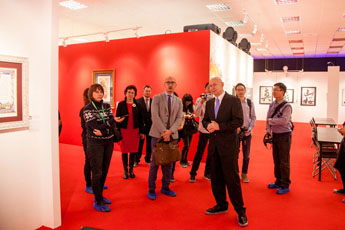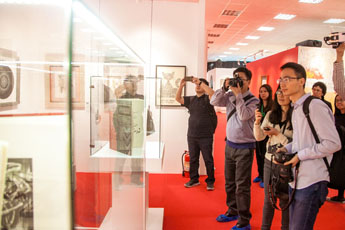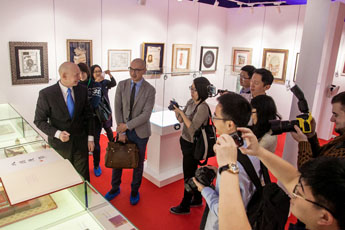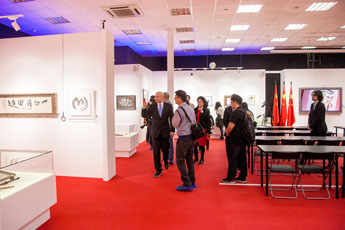Alexey Shaburov gave a tour of Contemporary Museum of Calligraphy for Chinese journalists
Director of the Contemporary Museum of Calligraphy Alexey Shaburov gave a tour for the journalists who came from China to cover “One Belt – One Road” exhibition of Chinese tea.
The museum exhibits calligraphy artworks from all across the globe, Chinese journalists saw the examples of Slavonic, European, Hebrew, Arabic, Japanese, and Chinese writing, as well as some unique handwritten articles, including the Constitution of the Russian Federation.
Shaburov particularly emphasized the artwork by Su Shishu, Chairman of Chinese Association of Calligraphers, one of the most renowned calligraphy artists from the Celestial Empire, and also the hand made book “Thirty Six Stratagems,” published by “Rare Books from Saint Petersburg” publishing house, in Russian and Chinese. Its handwritten text was authored by calligraphy artist Denis Lotarev, and acknowledged calligraphy professional and trainer of “Chieng Neng Li” Russian and Chinese centre in Saint Petersburg, Luo Lei. Both artists maintain close cooperation with the Contemporary Museum of Calligraphy.
Welcoming the Chinese guests, Alexey Shaburov couldn’t but shared the details of the events held in the museum to celebrate the 70th anniversary of establishing diplomatic ties between Russia and China. Planting a birch tree to celebrate the friendship between the two great countries, featuring the former Ambassador Extraordinary and Plenipotentiary of China to Russia Li Hui, and the Deputy Chairman of the State Duma Committee for Education and Science Lyubov Dukhanina, and performance of one of the leading Chinese musical bands, an ensemble of “Lu” Shangdong theatre (Jinan, Shangdong), proved to be the most significant ones.
The journalists were also keen to know that this year Sokolniki Exhibition and Convention Centre, which hosts the tea exhibition, partnered with “The Road of Friendship” motocross. It started in Beijing on April 27 during the President of Russia Vladimir Putin’s stay in China, and finished on June 4, 2019, in Moscow as the President of the People’s Republic of China Xi Jinping paid a return visit. The total route covered more than 9000 kilometers through Beijing, Manchuria, Zabaikalsk, Ulan-Ude, Irkutsk, Krasnoyarsk, Novosibirsk, Chelyabinsk, Kazan, Moscow, and Saint Petersburg.
A presentation of the “Great Chinese Calligraphy and Painting” exhibition was also shown to the guests; it was made even prior to the exhibition opening and contributed significantly to the understanding of Chinese national culture. It helped unlock the charming and beautiful Chinese writing, and, according to all who supported the event, played a major role in it.
The event was supported by the Ministry of Culture of the Russian Federation, the Ministry of Foreign Affairs of the Russian Federation, the Russian State Duma Committee for Education and Science, the Russian State Duma Committee for Culture, the Russian Federal Assembly Federation Council Committee for International Affairs, the Embassy of China to Russia, China Cultural Centre in Moscow, the National Union of Calligraphers of Russia, “Sharp-pointed Nibs” calligraphy association, Zhang Hai Institute of Contemporary Calligraphy, and Chinese National Association of Calligraphers.
The opening ceremony of the exhibition featured the following:
- Ivan Melnikov, the Deputy Chairman of the Russian State Duma, and Chairman of the Association for Russian and Chinese Friendship;
- Elena Greshnyakova, a member of the Federal Assembly Federation Council of Russia, a member of the Federation Council Committee for Science, Education, and Culture;
- Lyubov Dukhanina, the Deputy Chairman of the Russian State Duma Committee for Education and Science, a deputy of the Russian State Duma;
- Natalia Pilyus, the Deputy of the Russian State Duma and member of the Russian State Duma Committee for Culture;
- Galina Kulikova, the Deputy Head of the Association for Russian and Chinese Friendship, owner of the Chinese Order of Friendship, the highest state award for foreigners;
- Mr. Su Fangjiu, the Minister Plenipotentiary of the Embassy of China to Russia;
- Mr. Zhang Huaqing, Chairman of “Sharp-pointed Nibs” Chinese national association of calligraphers;
- Mr. Zhao Xueli, Director of the Academy of Calligraphy and Painting at the Chinese People’s Political Consultative Conference in Heilongjiang province, and calligraphy artist;
- Mr. Fu Jihong, the Deputy Chairman of the International Relations Office in Shanghai government.
Alexey Shaburov rounded the tour up with the following speech: “Until lately, calligraphy hasn’t been seen as an art in Russia. Or, more precisely, it fell outside of the framework of law. Thanks to our museum, this year some of the artworks, including those of Chinese origin, were made a part of the non-public section of the Russian Museum Collection, which means they were acknowledged as the Russian cultural heritage, and would protected for as long as the state continues to exist. The above has been verified with the Russian official stamp and an expert evaluation made by the State Museum of Oriental Art.”
Calligraphy — the written beauty of feelings.







